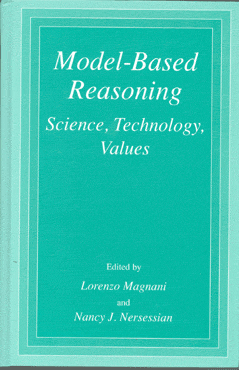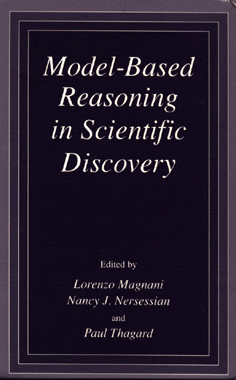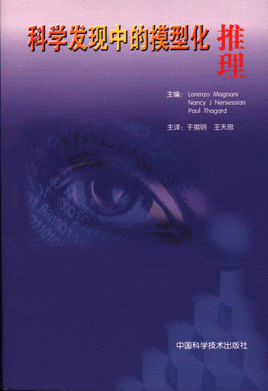


L. Magnani and N. J. Nersessian (eds.) (2002), Model-Based Reasoning. Scientific Discovery, Technological Innovation, Values, Kluwer Academic/Plenum Publishers, New York.
L. Magnani, N. J. Nersessian, and P. Thagard (eds.) (1999), Model-Based Reasoning in Scientific Discovery, Kluwer Academic/Plenum Publishers, New York, 1999 (Chinese edition, translated and edited by Qiming Yu and Tianen Wang, China Science and Technology Press, Peking, 2000).
Many psychological and physiological studies have been carried out to describe the multiple functions of mental imagery processes: there exists a visual memory that is superior in recall; humans typically use mental imagery for spatial reasoning; images can be rebuilt in creative ways; they preserve the spatial relationships, relative sizes, and relative distances of real physical objects. Kosslyn e Koenig (1992, p. 28) introduce visual cognition as follows:
Many people report that they often think by visualizing objects and events [...] we will explore the nature of visual cognition, which is the use of visual mental imagery in thinking. Visual mental imagery is accompanied by the experience of seeing, even though the object or event is not actually being viewed. To get an idea of what we mean by visual mental imagery, try to answer the following questions: [...] How many windows are there in your living room? If an uppercase version of the letter n were rotated 90° clockwise, would it be another letter?
We can build visual images on the basis of visual memories but we can also use the recalled visual image to form a new image we have never actually seen. Certainly, imagery is used in everyday life, as illustrated by the previous simple answers, nevertheless imagery has to be considered as a major medium of thought, as a mechanism of thinking relevant to hypothesis generation. Some hypotheses naturally take a pictorial form: the hypothesis that the earth has a molten core might be better represented by a picture that shows solid material surrounding the core. There has been little research on the possibility of visual imagery representations of hypotheses, despite abundant reports (e.g. Einstein and Faraday) that imaging is crucial to scientific discovery. It is well-known that the German chemist Kekulé‚ used spontaneous imagery to discover the structure of benzene; Watson and Crick have reported the use of mental imagery in the interpretation of diffraction data and in the determination of the structure of the DNA molecule.
The central theme of the recent imagery debate in the cognitive science has concerned the problem of representation. How can we represent images? Are mental images represented depictively in a picture or like sentences of descriptions in a syntactic language? According to Kosslyn’s depictionist or pictorialist view, mental images are quasi-pictures represented in a specific medium called the visual buffer in the mind. Kosslyn builds the analogy that visual information stored in memory can be displayed as an image on a CRT screen. Kosslyn’s model of mental imagery proposes three classes of processes that manage images in the visual buffer: the generation process forms an image exploiting visual information stored in long-term memory, the transformation process (for example, rotation, translation, reduction in size, etc.) modifies the depictive image or views it from different perspectives, the inspection process explores patterns of cells to retrieve information such as shape and spatial configuration. According to Pylyshyn’s descriptionist view mental imagery can be explained by the tacit knowledge used by humans when they simulate events rather than by a pictorialist view related to the presence of a distinctive mental image processor. As shown by certain experimental results, Hinton proposes that imagery involves viewer-centered information appended to object-centered structural descriptions of images. Finke proposes five unifying principles of mental imagery to summarize some of the properties of imagery that a computational model should represent.
In Glasgow and Papadias’ computational model the imagery processes are simplified by a depictive knowledge representation scheme that involves inferencing techniques related to generation, inspection and transformation of the representation. According to Kosslyn’s cognitive model, the knowledge representation scheme of mental imagery is composed of two different levels of reasoning, visual and spatial, the former concerned with what an image looks like, the latter depending on where an object is located relative to other objects. The different representations of these ways of reasoning exist at the level of working-memory and are generated (according to Kosslyn’s theory of imagery) from a descriptive representation of an image stored in long-term memory in a hierarchical organization. The separate long-term memory contains visual and spatial information as descriptions. The spatial representation outlines the image constituents in a multi-dimensional, symbolic array, that maintains spatial and topological properties and avoids distracting details, in accordance with the features of the image domain and the questions involved; moreover, the arrays are nested, to express multiple levels of the structural hierarchy of images. The spatial representation is processed using primitive functions that transform and inspect the symbolic array. The functions implemented express simple operations and reasoning techniques based on the transformation and inspection of image representations. Moreover, a multi-dimensional array is able to depict spatial and topological relations among image parts and can also denote non-spatial dimensions such as speed. Sometimes, a part occupies more than one element in the array, to capture all the spatial relationships involved.
Peirce interpreted abduction essentially as an inferential creative process of generating a new hypothesis. There are two epistemological meanings of the word abduction: 1) abduction that only generates plausible hypotheses (selective or creative) and 2) abduction considered as inference to the best explanation, that also evaluates hypotheses. All we can expect of our “selective” abduction, is that it tends to produce hypotheses that have some chance of turning out to be the best explanation. Selective abduction will always produce hypotheses that give at least a partial explanation and have a small amount of initial plausibility. We should remember, as Peirce noted, that abduction plays a role even in relatively simple visual phenomena. Visual abduction, a special form of non verbal abduction, occurs when hypotheses are instantly derived from a stored series of previous similar experiences. It covers a mental procedure that tapers into a non-inferential one, and falls into the category called “perception”. Philosophically, perception is viewed by Peirce as a fast and uncontrolled knowledge-production procedure. Perception, in fact, is a vehicle for the instantaneous retrieval of knowledge that was previously structured in our mind through inferential processes. By perception, knowledge constructions are so instantly reorganized that they become habitual and diffuse and do not need any further testing. Many visual stimuli are ambiguous, yet people are adept at imposing order on them: “We readily form such hypotheses as that an obscurely seen face belongs to a friend of ours, because we can thereby explain what has been observed” (Thagard, 1988, p. 53). This kind of image-based hypothesis formation can be considered as a form of visual abduction (Magnani et al., 1994).
Kosslyn, S. M. & Koenig, O. (1992). Wet Mind. The New Cognitive Neuroscience. New York: Free Press.
Magnani, L., Civita, S. & Previde Massara, G. (1994). Visual Cognition and Cognitive Modeling. In V. Cantoni (Ed.), Human and Machine Vision: Analogies and Divergences, New York, Plenum Press, pp. 229-243.
Thagard, P. (1988). Computational Philosophy of Science. Cambridge, MA: The MIT Press.
References about Philosophy of Science and Computational Methods
Go back to the other areas of research